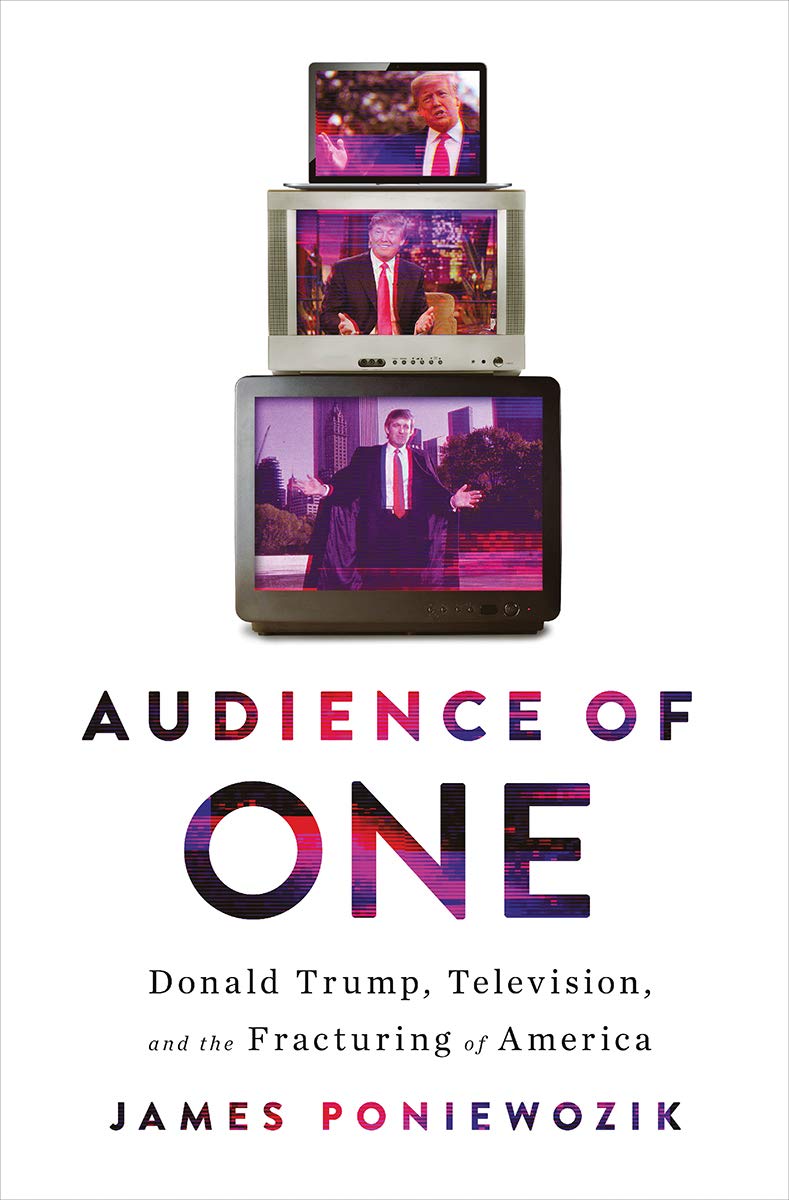
Audience of One: Donald Trump, Television, and the Fracturing of America, James Poniewozik; Liveright, 2019, 304 pages
The past few years have seen the publication of a slew of books belonging to a new area of enquiry that we might call Trump Studies. Poniewozik’s fine study can take its place alongside works such as Charlie Sykes’ How the Right Lost Its Mind and Fire and Fury by Michael Wolff. It is also intended as a follow-up to Neil Postman’s ground-breaking work on television. Poniewozik’s subject is a nexus between Trump, on the one hand, and entertainment and media, on the other. Crucially, while new media is of great consequence in this story, it is certain aspects of movie and TV culture along with cable news that Poniewozik emphasizes most when explaining what made possible the rise of Trump.
"Crucially, while new media is of great consequence in this story, it is certain aspects of movie and TV culture along with cable news that Poniewozik emphasizes most when explaining what made possible the rise of Trump."
He divides his discussion into three parts, honing in on the fusion of man and media in each. We proceed chronologically, through the last decades of the twentieth-century, where the focus is first the vicissitudes of Trump’s earlier career, and then the first two decades of this century, which culminate with the time of his first administration.
His initial key concept is TV’s “Least Objectionable Program.” A rehearsal of his argument might run as follows. When there were only three TV networks in the United States, the programming of channels was always structured around programs that no one could find objectionable. That way, no viewer had a reason to change channel or switch off. Something of a TV common culture persisted, even if it was a fully commercial common culture. But with the rise of cable TV, this culture started to weaken. On cable, the viewer could access something slowly approaching a kind of bespoke broadcasting: you could hunt down channels and programs more neatly tied in with your taste. As a consequence, the audience started to fragment, but this was only the beginning; social media, would take this customization to the next level. Social media, observes Poniewozik, is “infinitely customizable.” It is Twitter, however, Trump’s communication medium of choice, that Poniewozik identifies as the tool that completes the revolution. On Twitter, it pays to be the “Most Objectionable Program.”
When discussing the apotheosis of this series of developments, Poniewozik uses hyperbole; but the exaggeration is fully justified as it throws into relief an important tendency in U.S pubic life today. The “audience of one” of the title might point to, for example, the Twitter user as audience, but Poniewozik entertains the notion that, ultimately, all “content” in the U.S today is increasingly tailored for one individual, namely the President. He explains how Trump needs to see things on television before he is satisfied. As a result, his team must constantly stage his version of reality for the cameras, so that, after having watched a hyperpartisan account of his achievements, he can move onto something else. “On The Trump Show,” states Poniewozik, “the president was the star of the TV series that he lived inside, but he was also its sole audience; it was the rest of the world that needed to be conscripted as a stage set and players, to perform the required story.”
Most interesting to my mind is the author’s account of the perfect storm across entertainment, news, and digital (discussed in Part II) that prepared the ground for Trump’s run for office. In one respect, the argument is that a whole new ethos (or amoral view) gets ushered in by antihero entertainments (films and TV programs), reality TV and Twitter. The author, however, misses a trick here. In a piece from 1944, “Raffles and Miss Blandish,” George Orwell expertly discusses the larger significance of the anti-hero entertainments of the time. That essay would have provided Poniewozik with a wonderfully suggestive bedrock for his ruminations on the (continued) rise of the antihero in twenty-first century entertainment. Orwell’s essay encourages us to think of this trend as almost a hundred years old, and Poniewozik’s attempt to cast it as a new phenomenon is unconvincing.
This endorsement – this is an endorsement – comes with two significant caveats. At one point the author bemoans a tribalist turn in U.S. broadcasting, but this is a deeply tribal book, perhaps even more tribal than the author realizes. It is infused with the worldview of the identarian left, and so it will grate on the nerves of two audiences, both worth having. Because it’s so anti-conservative, Never-Trumpers, who should like it, will repeatedly find their hackles rising. (The author momentarily extends sympathy to “cuckservatives,” but he is obviously not interested making a play for that group.) And because, throughout, it reverts to the argot of grievance studies (at one point the ‘60s TV series I Dream of Jeannie is cast as a “fantasy/female-imprisonment-comedy”), those on the left sick of listening to what Todd Gitlin once called “the cant of identity” will frequently baulk at its idiom as well.
The book’s tribal nature also helps us to understand a curious fact about it. If we take Poniewozik’s account of “The Trump Show” to be the main iteration of the book’s central point, curiously enough, the conception of “narcissism” is not explicitly referred to in that statement or the surrounding commentary. This is all the more surprising because in between the book’s two early references to Christopher Lasch, and before the references to Lasch peter out entirely, the author explicitly calls Trump a narcissist. Why should Poniewozik have found it difficult to use a potentially essential source, when he has no difficulties with other sources such as Postman? An explanation does suggest itself. In his lifetime, Lasch was unpopular with the left; as the nature of his legacy becomes clearer, if anything, he only becomes a more difficult figure for the left. “The therapeutic model midwifed the birth of identity politics,” Francis Fukuyama remarks critically in his recent book Identity. Arch-critic of the therapeutic society, Lasch is one of the chief critics of the change in culture which ushered in today’s cultural left. Alas, Audience of One proved too partisan a project to accommodate his legacy.

